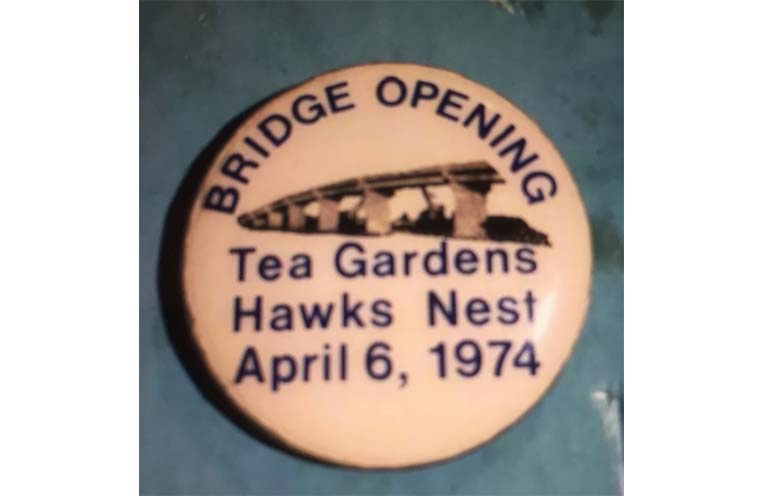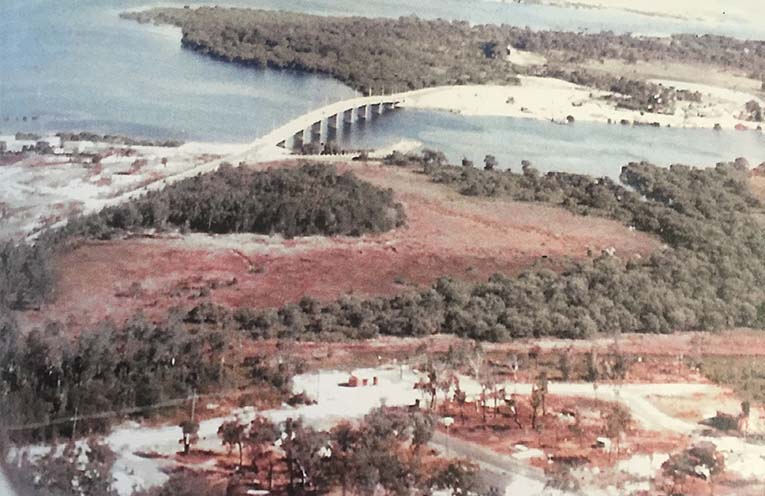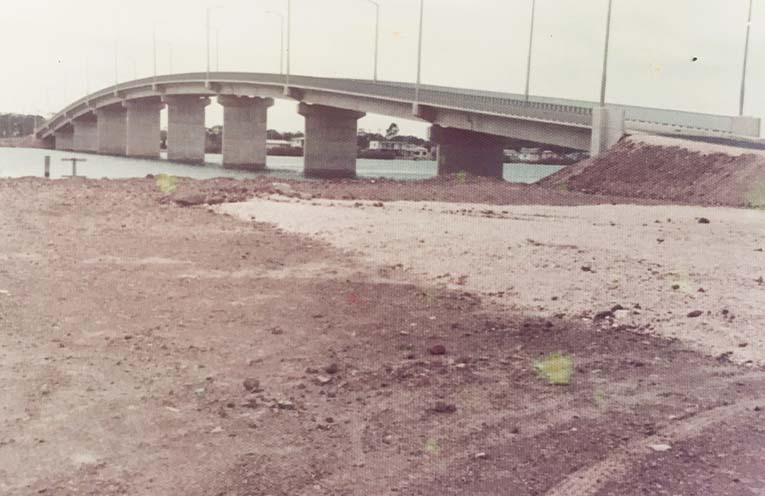
HAPPY 50th Birthday to our precious Singing Bridge – a Golden Anniversary to be sure!
When gazing at the bridge it is rare not to see traffic passing, but let’s reflect on its history.
The Hawks Nest settlement started about 150 years ago with the timber mills, hotel and first school.
At that time the children from Tea Gardens had to be rowed across the river each day by the teacher.
This did not last!
Although the government eventually provided a boat, the Hawks Nest School eventually closed in 1888 and a provisional school with eighteen pupils was opened in Tea Gardens.
The teacher, Peter Krackow, was transferred across the river, but the rowing was still considered part of his duties.
Due to a major economic depression, the timber industry in Hawks Nest failed in the 1890s, but in Tea Gardens the fishing industry was thriving and the township was growing.
The only transport at this time was by water.
When the timber industry steadied, Allen Taylor’s mill at Winda Woppa kept local men busy from 1916.
They travelled to work by ferry and in 1928 Henry Melvin Engel tested the water by using an oyster punt to transport two vehicles between the twin towns.
As the need increased, so did the size and capacity of the ferries until in the 1970s a sixteen car ferry was operating, but it still was sadly inadequate for the volume of traffic, especially in the holiday season.
I still feel a sense of nostalgia when remembering crossing on the ferry, then walking to the beach in the late 1940s and ‘50s.
There were only a few houses scattered along the Hawks Nest riverfront.
A bush track led through to the main beach where there was The Pavilion built by the Stroud Shire Council in 1936, the camping ground and one small cottage almost on the beach.
That bush track is now known as Booner Street!
There were only two families with children living at Winda Woppa in the 40s.
When I was attending the Tea Gardens School the McRae and Asquith children would bring a boat from Winda Woppa to Green Point then walk across the moor to school, where they put on their shoes.
This was shorter than walking up the rough track to the ferry and then waiting to cross.
Motor traffic only started in the area in the 1920s and was slow to increase due to the condition of the roads, then the Great Depression of the ‘30s and war in the ‘40s.
Reliance was on the local daily bus service to Newcastle or the ferry to Nelson Bay, which like today was subject to the vagaries of the weather.
In 1960 the Shire Clerk recorded 27 families, including sixteen pensioners and eleven cars for Hawks Nest, while there were 102 families and 70 cars in Tea Gardens,
The Hawks Nest beaches were a big attraction, however, and miners from the Hunter Valley flooded into the area in holiday times, patiently waiting to cross on the ferry, then to pitch their canvas tents and unload the supplies they had to bring with them, as there was no general store in Hawks Nest.
By 1963 a Golf Course was planned, with 54 acres of Crown Land secured, followed by a further 55 acres.
In 1965 Mineral Deposits planned to move one of their separation plants to Hawks Nest. Extraction was to start in 1966 and the pressure was on!
With 40,000 tons each of rutile and zircon to be extracted each year, transporting the minerals became a big problem.
The ferry could not cope so the road past Mungo Brush was extended to Seal Rocks to connect it to the Lakes Way, then by the main road to the Port of Newcastle.
This was a costly diversion and Mineral Deposits were happy to contribute $31,000 towards the construction of the bridge which was estimated to cost $1,200.000 – back then a substantial amount.
Subdivision and sale of Crown Land in Hawks Nest were scheduled to help defray the cost.
The building of the bridge commenced in March, 1972, and as we know, it opened with a great sense of relief and expectation for the ongoing development of our area on 6 April, 1974.
In Tea Gardens, Myall Street was extended to meet the bridge and thus become the main road, which in turn left Marine Drive and the riverside a much quieter and more pleasant area.
On the Hawks Nest side direct access to Moira Parade was cut off and the main road to Tea Gardens became Kingfisher Avenue, with the land in Swan Bay being opened up for development.
To mark the anniversary, Tea Gardens Family Research and Local History Inc. will be mounting a display in the Tea Gardens Library for the whole month of April, and will also be supporting the activities at the Tea Gardens Hotel on 6 April.
Come along and see the photos and souvenirs of the opening and read about the changes the bridge brought to our twin towns.
By Anne JOHNSON, Tea Gardens Family Research and Local History Inc.

